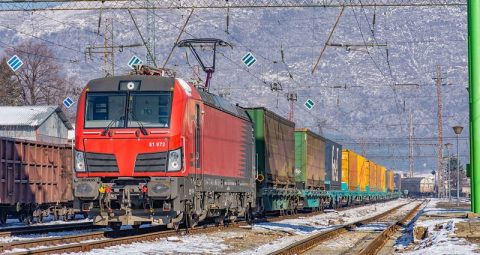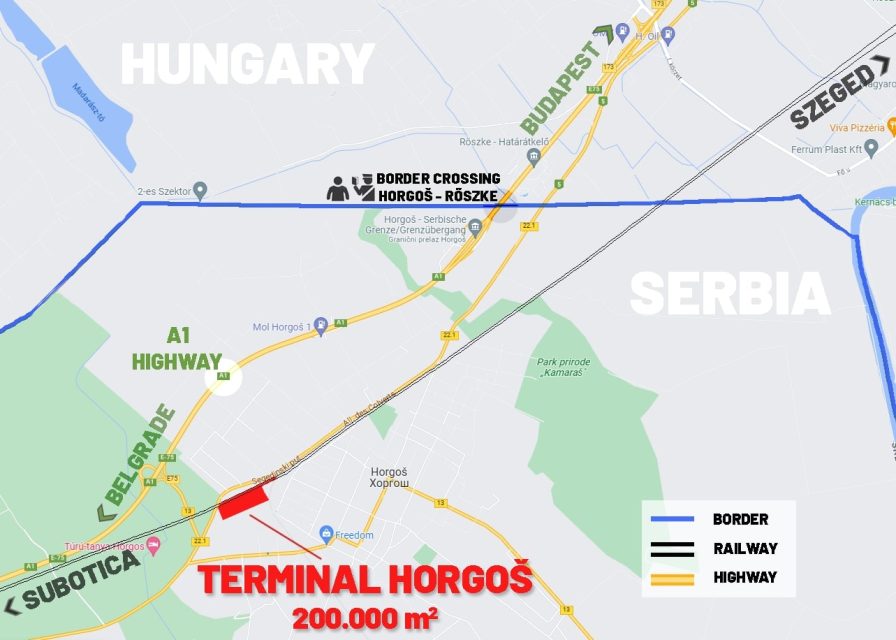How can this new terminal boost EU-Balkans intermodal transport?
28 March 2023
A new project is in the pipeline to facilitate rail freight movements between Serbia-Hungary and Balkans-EU, respectively. The Horgos Terminal will have four 740-metre-long tracks and could assist in considerably speeding up customs procedures while becoming the new intermodal gateway between EU railway tracks and Balkan motorways.
“As Horgos is a border station, railway undertakings will be allowed to enter without a Serbian-issued safety certificate based on mutual recognition between Serbia and Hungary”, says Rihard Dobo, CEO at Dibex doo and Roadex Trans kft and initiator of the Horgos Terminal Project.

On 19 April, Rihard Dobo will also speak at the RailFreight Summit Poland. He will explain the significance of the Horgos Terminal project and its potential to boost intermodal traffic to and from the Western Balkans and the broader southeast Europe region.

The Serbia-Hungary bottleneck
“As Serbia and the wider Western Balkan region is not part of the EU, border crossing procedures apply by both the Serbian and Hungarian (EU) custom authorities according to custom rules for goods from/to third countries”, explains Dobo.
Simply put, any freight consignment by road or rail must pass the Serbian and Hungarian customs clearings. The double customs clearance results in long queues of trucks and, respectively, in waiting times that can reach up to 36 hours. At the same time, Dodo adds that there are only two border crossings for road traffic, and “their capacity does not correspond to current needs”.
Concerning rail freight traffic, the situation is similar. Despite the recently opened Szeged-Horgos-Subotica railway line, the Subotica border crossing is the only one functioning between Serbia and Hungary, handling less than 20 pairs of freight trains daily. “That is because the Horgos border station is not equipped for customs clearance of freight trains”, explains Dobo.
Shifting semi-trailers to rail
Interestingly enough, Dobo is the CEO of two road transport companies. So why would a road transport professional advocate constructing an intermodal terminal, including rail? “Due to the low level of containerisation in lorry transport for Serbian exports and imports and the lack of intermodal train services to serve the Serbian market, the main challenge we face is to increase freight transport containerisation and to shift containers and semi-trailers to rail”, explains Dobo.
Regarding containerised cargo, there are some alternatives in place. For instance, Serbian containers are directed mainly to the ports of Rijeka and Koper. However, according to Dobo, no terminal serves semi-trailer transhipments to/from trains in Serbia. Constructing an intermodal terminal like the one in Horgos would help the Serbian market attract more rail and intermodal flows, which will be served in a single location.
In this way, rail will become more attractive in Serbia since intermodal growth will boost its market share. Simultaneously, it will alleviate the already congested rail and road border crossings with Hungary. In brief, it’s a win-win situation.

Don’t forget the customs
Border crossings between Serbia and Hungary are crucial. “Apart from the Serbian market, these border crossings serve the transit routes from Turkey, Greece, Bulgaria and non-EU Western Balkan countries towards Western and Central Europe”, continues Dobo. Understandably, a large intermodal transhipment terminal would significantly improve the cargo flows from various markets.
Most importantly, though, it would change the situation with customs clearance procedures, which many claim is the main problem since Serbia is not an EU member. “Extending the capacity of customs with a new customs terminal, where both the Serbian and Hungarian authorities could work together, is of utmost importance. Such a terminal would facilitate the speed of customs clearance and provide estimated arrival times and timetables for the departure of containers and semi-trailers.
An alternative for rail freight
The Horgos terminal will be constructed right next to the Budapest-Belgrade line. The rail industry has long awaited this line as it will become the main artery for high-speed trains from the Balkans to Central Europe. However, Dobo underlines that “as the line is planned for 200km/h passenger operations, freight traffic certainly will have limits after the reconstruction is finished”.
In this sense, the recently opened Subotica-Horgos-Szeged-Budapest route could become a more freight-friendly alternative by using the railway line No.140 Szeged-Budapest. Additionally, the terminal in Horgos could also function as the main transit station for trains between Serbia-Hungary, serving intermodal traffic and providing bundled customs services.
RailFreight Summit Poland
Do you want to follow the discussion about the Horgos terminal and its significance for rail freight and intermodal transport at the RailFreight Summit Poland? You can attend this summit and join the discussion. Have a look at the programme or register for the event, which will take place on 19 & 20 April 2023 in Warsaw.
morenews
Networking dinner 1
Networking dinner Networking is the most crucial element of RailFreight Summit! On the evening of 16 April 2024 from 18:00-21:00, a networking dinner will take place. This seated dinner offers the perfect opportunity to get together with your fellow industry professionals in a formal setting. Enjoy a multiple-course dinner, and drinks while making important new… Read more ›
Malaszewicze upgrade may be financed by Polish government
The EU has in fact decided not to fund the modernisation project planned in the Małaszewicze Transshipment Area. The area includes the terminals Kobylany, Małaszewicze, Bór, and Chotyłów. This project was put on hold, waiting for possible public funds, which now may be on their way. To see this crucial transshipment area with your own… Read more ›
DB Netze’s new freight coordinator: ‘Construction works are for the better, but I understand frustration’
Germany is in all networks At the RailFreight Summit, which will take place in the capital city Warsaw, Dieter will discuss the possibilities of increasing capacity in the German railway network. “Germany is in most traffic flows, so all issues in Germany are directly seen and felt abroad. “We need a common understanding of managing… Read more ›
